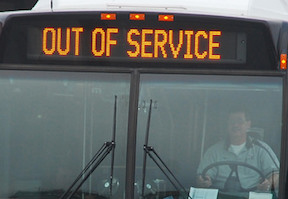
Big, bad bus: START should stop
Big, bad bus: START needs to stop
Take a quick glance at the 2017 SPET proposals. One thing jumps out. START Bus has three of the 10 asks, tying up nearly half the record-setting $68.6M in projects on the ballot. At $30,130,000, this would be the total SPET ballot in most years.
And it’s hardly surprising. This agency has been burning money for more than a decade. Public subsidies have kept START afloat—to the tune of $60 million over the last 10 years. Every year taxpayers bear the burden of bailing out the bus, forking over $3 million, annually.
And it’s getting worse. Operating costs are expected to go up, again, next fiscal year by $491,000 (a 15% jump). Conservative estimates say START will lose another $5.4M in 2008.
But instead of belt-tightening and trying to figure out how they can stop the bleeding, START is stomping on the gas, pedal to the metal. They want new buses (they have about 30 now). They want housing for their administrators, mechanics and drivers. They want more bus storage space and a bigger maintenance facility, even after building their current $17M space. Their master plan calls for another $30 million in upgrades to their Karns Meadow bus barn.
These numbers are eye-popping; and there’s more.
The Integrated Transit Plan (ITP) calls for a doubling of ridership by 2024, and a doubling again of that by 2035. Lofty goals for a mass transit system that has stalled on ridership numbers since 2008. The plan also calls for START’s fleet to grow to 60 buses by 2024, and 120 buses by the year 2035.
START cannot afford to run the buses they have now. How will they ever fuel and hire drivers for 120 buses? Assuming they can find the money to purchase that many.
Are these targets attainable? The former START director didn’t think so. He’s no longer with the agency.
START’s aggressive spending spree has already walloped taxpayer’s right in wallet. The bussing business anticipates losing $8.1 million a year by 2024. They admit they’ll likely be running $18 million in the red by 2035.
And for what? It is estimated that public transit in Teton County accounts for 1% of all trips made in the valley. At best, the agency hopes to grow that number to 3% by 2024. So, the bus is not removing cars from the road. In fact, at least one industry expert says the idea buses are a solution to gridlock and traffic jams is foolhardy.
“As far as buses taking anybody off the road, that’s a real mythical notion,” Wendell Cox said. Cox is a respected urban planner and leading expert in American mass transit. Of Jackson Hole, Cox added, “You will probably not find a larger transit system for a community your size.”
Mass transit only really works when it’s transporting masses—and Jackson Hole simply isn’t there…yet. We don’t have the people, the roads, or the routes. But folding a monstrous bus system with a ballooning budget into a hyper-growth agenda seems to be our electeds’ plan toward a metropolitan utopia.
